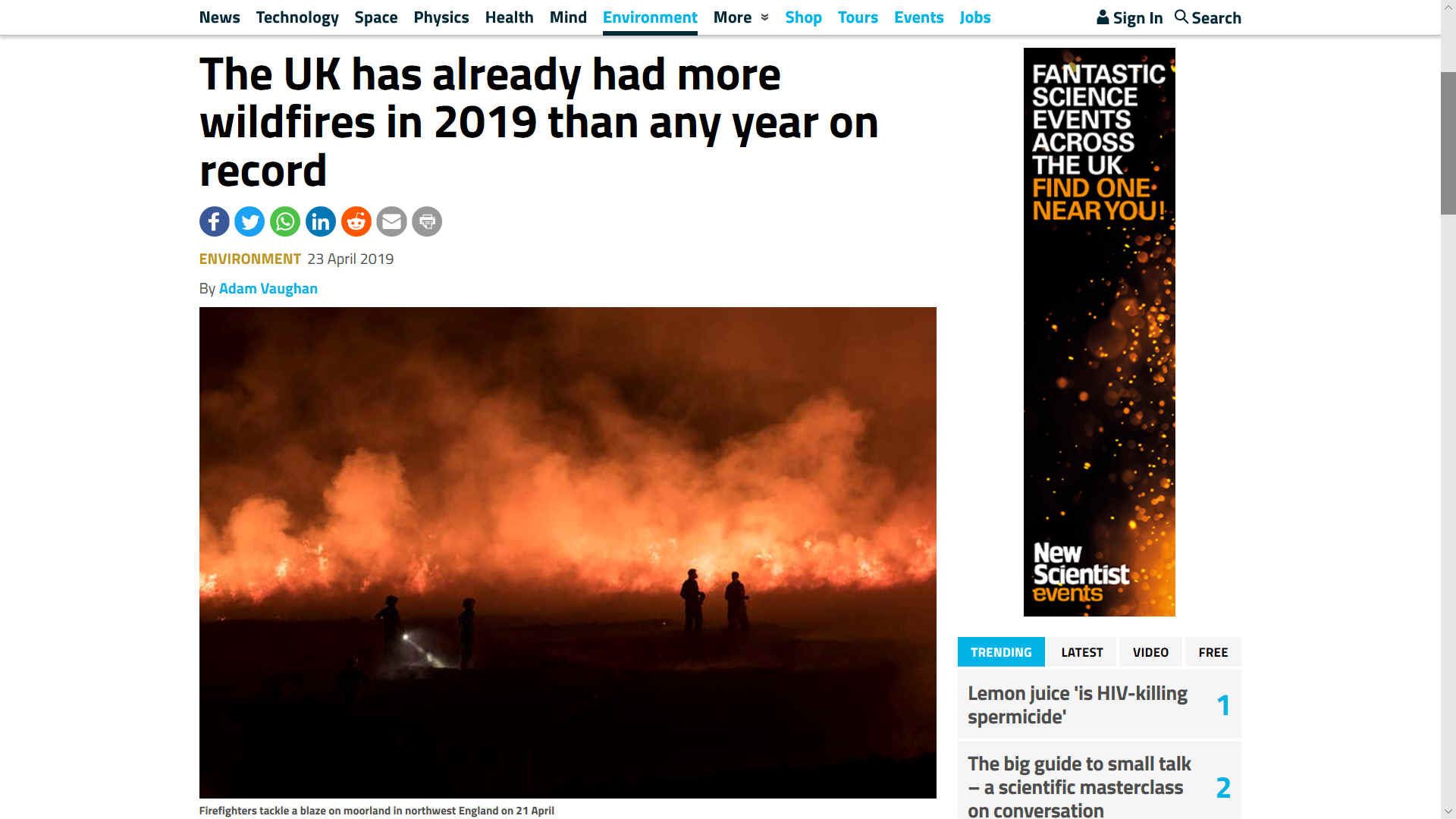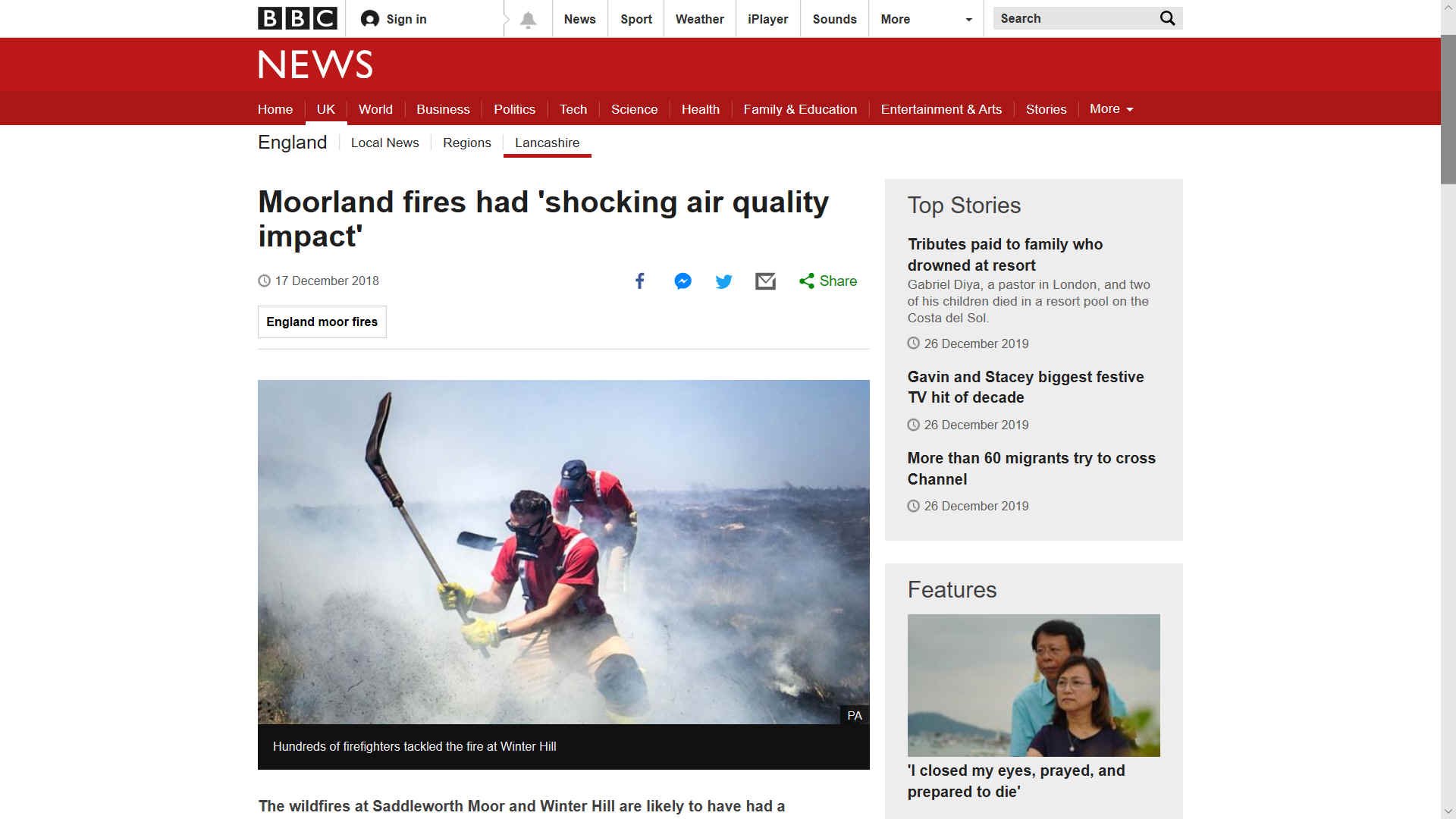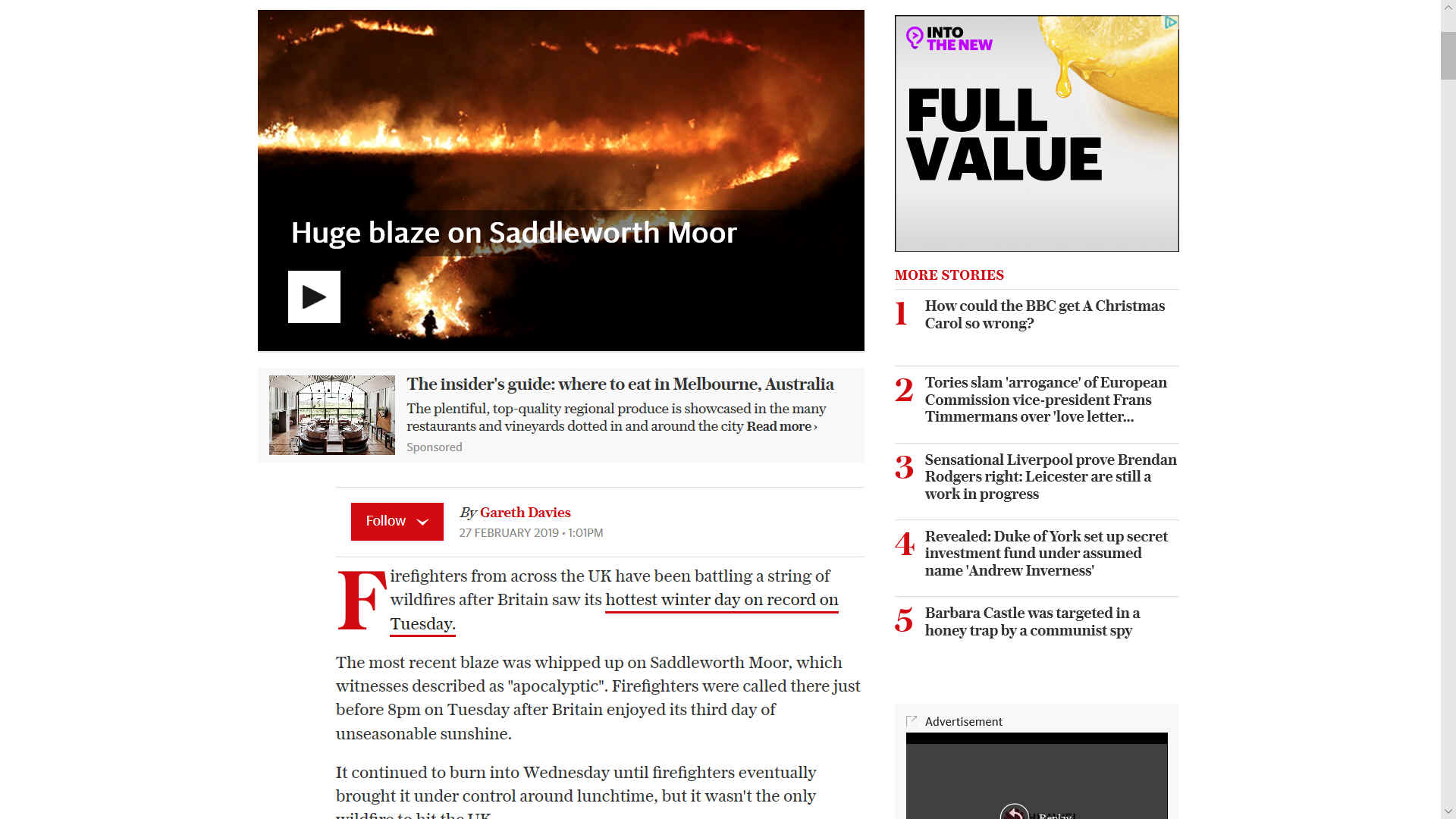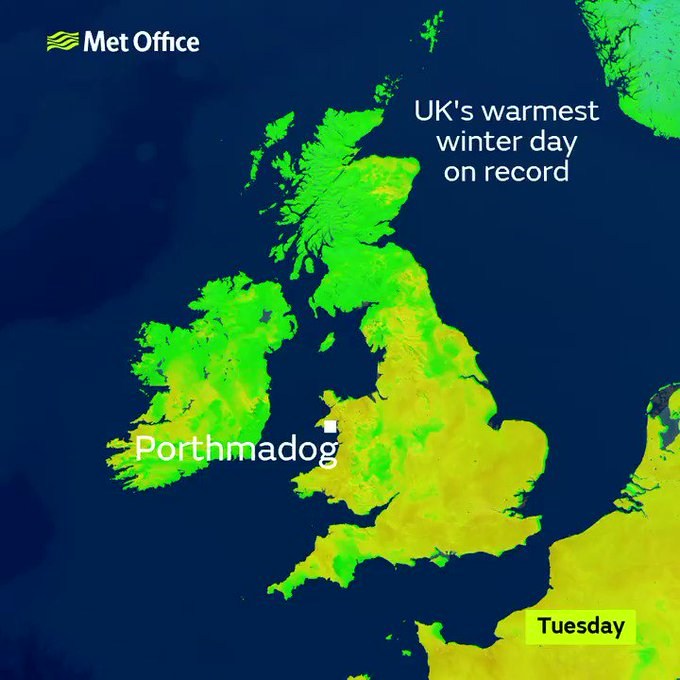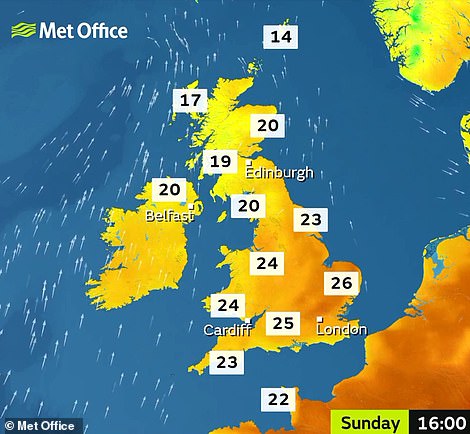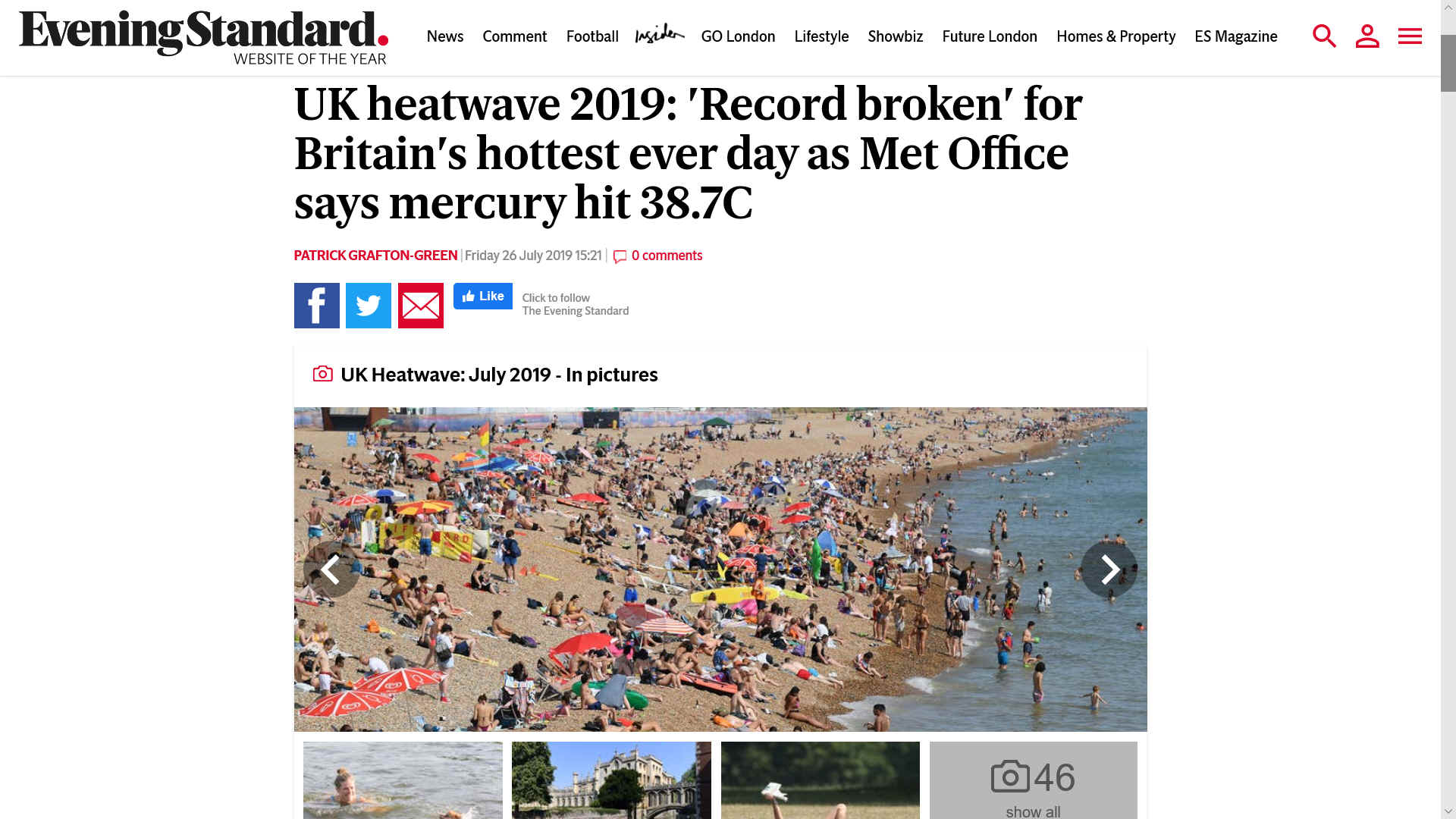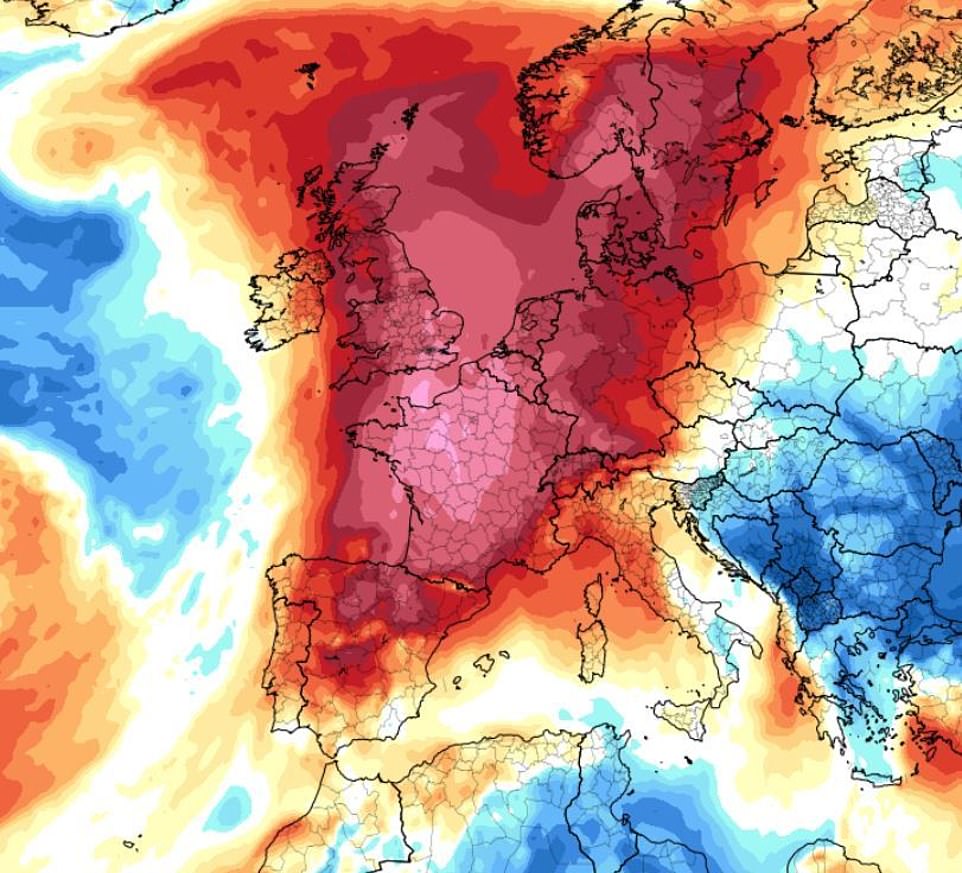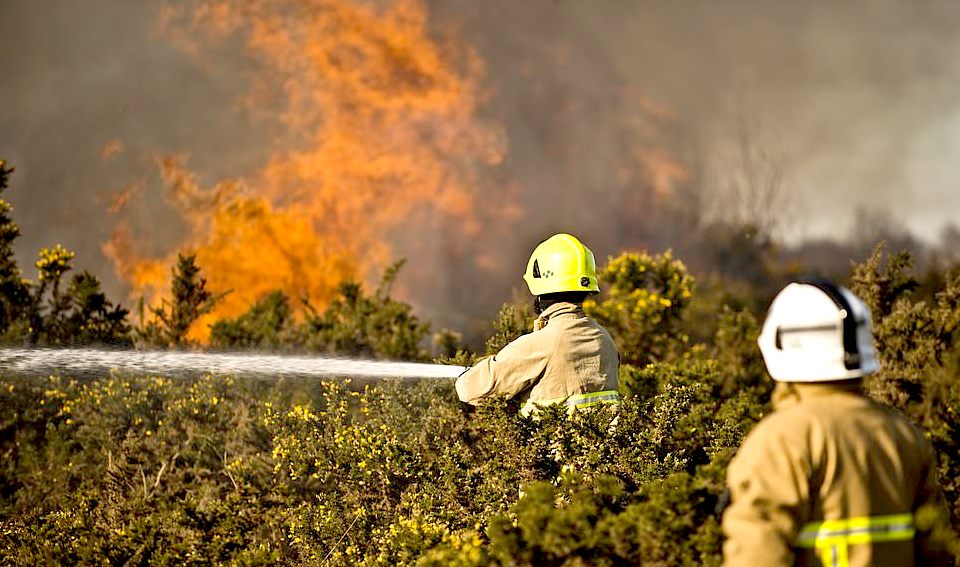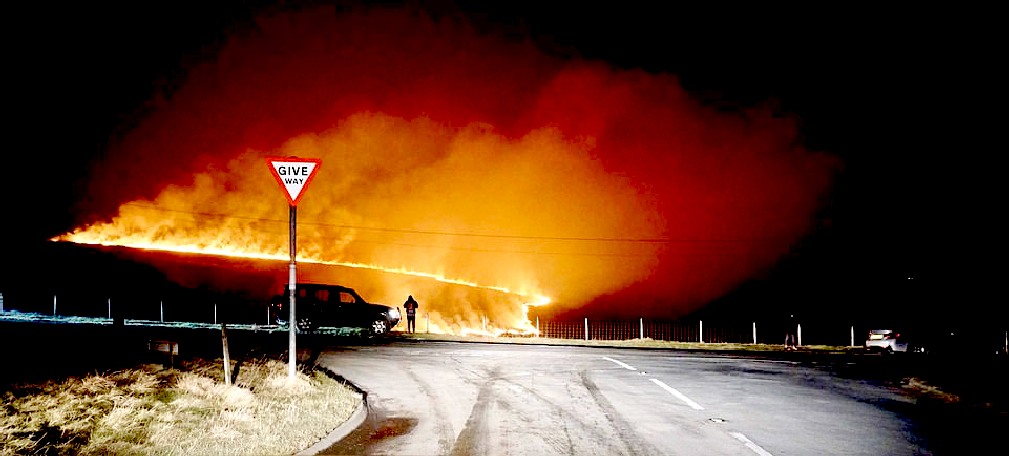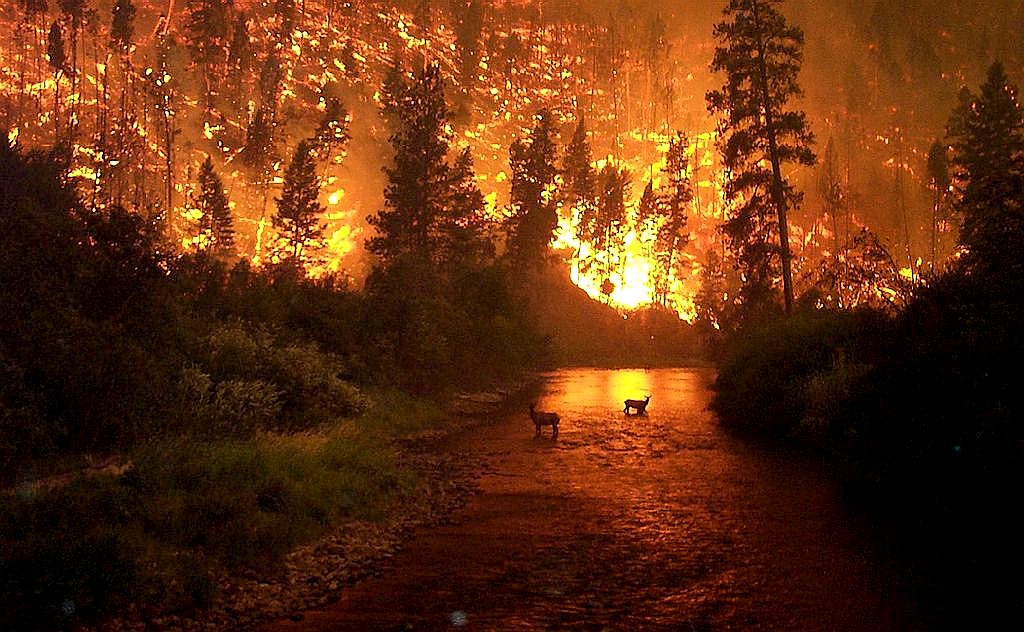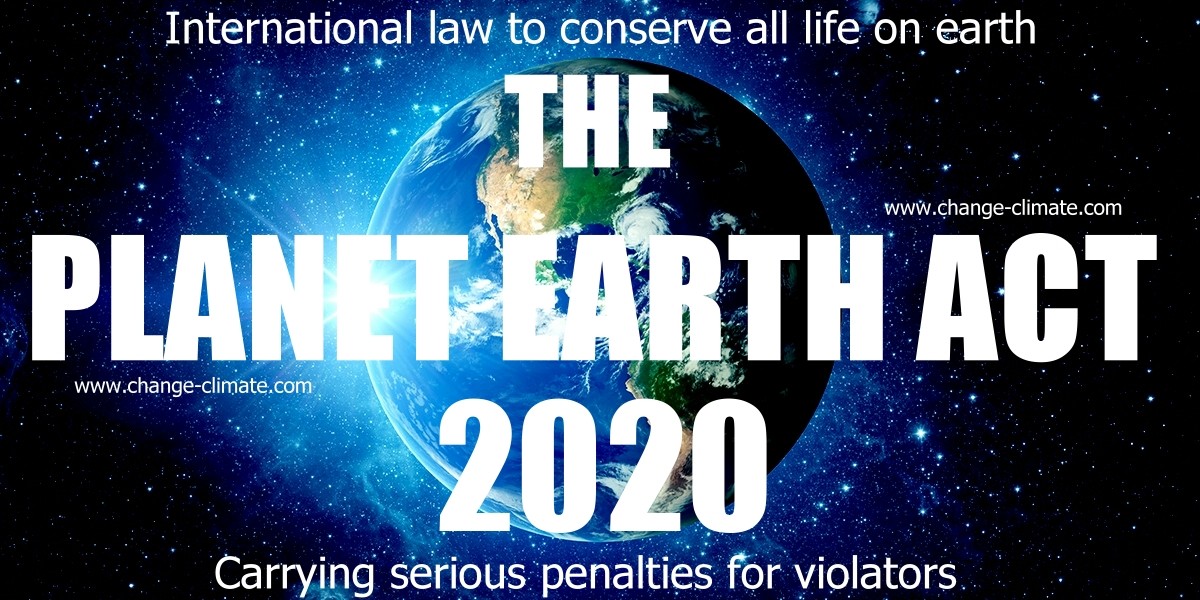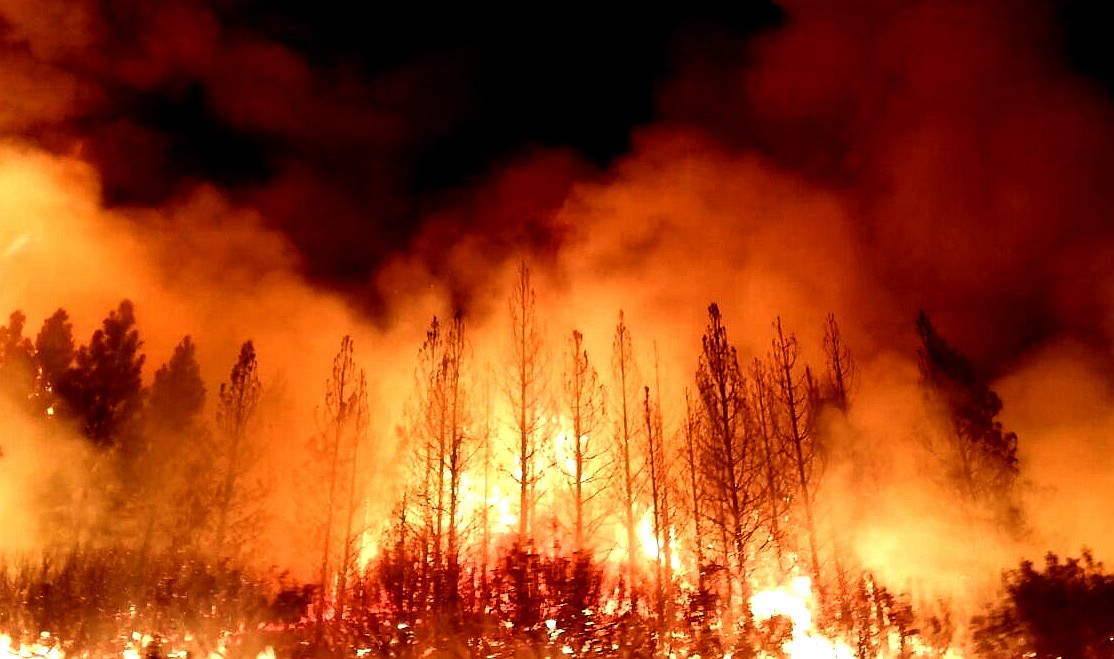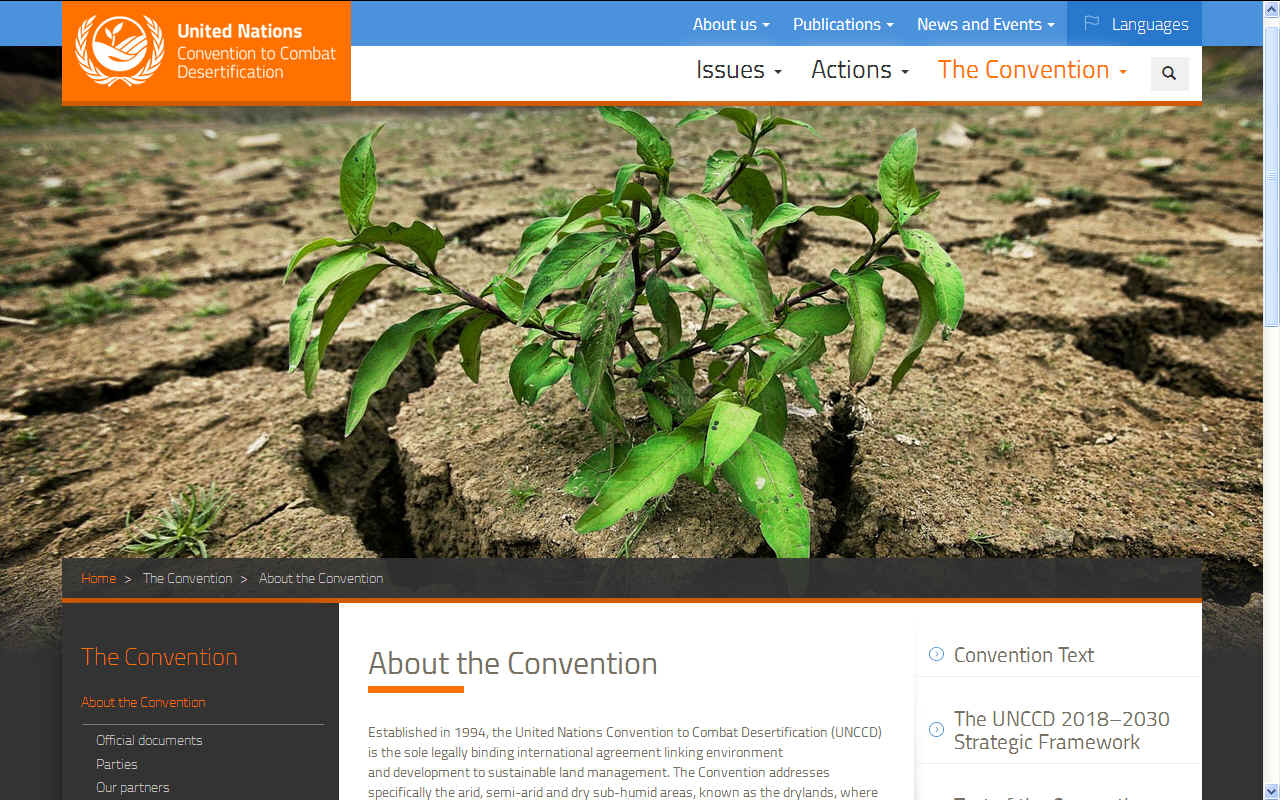|
UK MOOR & FOREST FIRES
Please use our A-Z INDEX to navigate this site |
||||||||||||||||||||||||||||||||||||
WORST 2019 - The 2019 United Kingdom wildfires are a series of wildfires which began on 26 February 2019, with the most recent fires occurring on 23 April 2019. These series of fires are most remarkable because they are happening at such an early date in the year. To add to this, these lands were already damaged by wildfires that burnt for months during the summer of 2018. The fires have created many air pollution problems for the UK. The causes of most of the fires have been attributed to much higher than average temperatures and drought conditions that have prevailed since the spring of 2018. As of 23 April, the number of wildfires in the UK in 2019 is at 96. This beats the previous record of 79 from 2018.
NEW SCIENTIST 23 April 2019
- The UK has already had more wildfires in 2019 than any year on record
The hot spell in February and the recent Easter heatwave have contributed to a total of 96 major wildfires of 25 hectares or larger, eclipsing the previous high of 79 across the whole of 2018.
More than 100 firefighters battled wildfires over the Easter weekend across Illkley Moor and Marsden Moor in West Yorkshire. Another fire broke out on moorland near Marsden on Tuesday afternoon, requiring ten fire engines to attend.
Fires throughout the year
There were also wildfires in Cornwall, Dorset, Derbyshire, Northern Ireland, the Peak District, Rotherham, Wiltshire and Wales, according to the National Fire Chiefs Council (NFCC).
Scotland was affected by fires across the Highlands, including a large one that posed a “serious risk” to the Moray windfarm.
The spate of blazes follows a series of major wildfires during the hot, dry weather of 2018, including the
Saddleworth Moor fire near Manchester, which burned for five days and made pollution levels spike.
The big change he has observed is that the wildfires are no longer confined to the traditional season of fires from late March to late September. “What seemed to happen last year and is happening this year, is we are not talking about a wildfire season – we are getting significant wildfires happening throughout the year,” says Hedley.
Barbeques and arson
Layered on top of that seasonal risk has been fire-friendly weather and an increased risk of ignition through accidents, such as a barbeque in the case of the West Yorkshire blazes, or arson.
“Both the fires in February and over this Easter weekend coincided with long warm dry periods with steady easterly winds – fire weather – and also with ignition risk from school holidays,” says Smith.
“I would argue that those statistics suggest that we are already experiencing climate change and that it has already led to increasing wildfire risk,” Smith adds. He says the past two years have been the worst for UK wildfires that he can remember.
The total area burned in 2019 so far is 17,199 hectares, almost on a par with the highs of 2018 and 2011, but with eight months of the year left to go.
The rural nature of most UK wildfires means relatively little property is damaged compared to the multibillion-dollar cost of Californian wildfires. But they draw fire engines away from towns and cities, increasing fire risk there, and can cause health problems by causing pollution levels to rise, as happened in Greater Manchester last year. By Adam Vaughan
BBC
17 DECEMBER 2018 - Moorland fires had 'shocking air quality impact'
Researchers said the impact of the summer fires on public health in the region could be "considerable".
When the fires were at their height, the legal limit for daily average exposure to particulate matter (50ppm) was breached on five occasions in different sites across Greater Manchester, the report by north of England think tank IPPR North says.
Monitoring stations also registered extremely high individual spikes in excess of 150ppm.
Report author and research fellow Jack Hunter said: "The impact of the fires at Winter Hill and Saddleworth Moor provide a timely reminder that we must not take the north's natural assets for granted. "If we don't value the natural environment properly, the consequences for people, the environment and the Northern Powerhouse economy can be disastrous."
Mr Hunter said policymakers "need to put the natural environment right at the heart of decisions" about the future of the north of England. Environmental concerns raised in the report follow previous research which found that Greater Manchester had "lethal and illegal" levels of NO2 air pollution.
2019 UK FIRES ROUNDUP
FEBRUARY
- February 2019 saw the highest winter temperature ever recorded in the United Kingdom, at 21.2 °C (70.2 °F) on the 26th in Kew Gardens, London. In addition to this, England, Scotland and Wales all broke their regional temperature records, with England and Wales exceeding 20.0 °C (68.0 °F) in winter for the first time.
APRIL
- A week-long warm spell around Easter sent temperatures up to 26 °C (79 °F) across parts of England. This, combined with drought conditions still prevailing, caused wildfires across many areas. This led to the Scottish Fire and Rescue Service to issue a warning for wildfires on 19 April.
Dartmoor
MAY
- On 13 May, a wildfire warning was issued for parts of Scotland as temperatures were expected to rise above average, combined with the long drought, creating perfect conditions for wildfires to occur.
TELEGRAPH
Firefighters from across the UK have been battling a string of wildfires after Britain saw its hottest winter day on record on Tuesday. The most recent blaze was whipped up on Saddleworth Moor, which witnesses described as "apocalyptic". Firefighters were called there just before 8pm on Tuesday after Britain enjoyed its third day of unseasonable sunshine. It continued to burn into Wednesday until firefighters eventually brought it under control around lunchtime, but it wasn't the only wildfire to hit the UK.
Dramatic photographs showed a huge fire burning on Arthur's Seat in Edinburgh as crews battled to bring around 800m of gorse under control having been alerted at 6.30pm.
Earlier in the afternoon, East Sussex Fire and Rescue had to extinguish two separate wildfires. The first, just before 3pm engulfed 35 hectares in Nutley, before another broke out around a mile away in Ashdown Forest.
Britain saw its hottest winter day on record on Tuesday when the mercury hit 21.2C (69.4F) in Kew Gardens, London.
Incident Commander Laura Boocock told the BBC it was "one of the biggest grass fires (she) has ever seen", but it was "nothing they can't handle". Witness Harry Broughton tweeted: "Never seen anything like this - had a drive up as these things look terrible. "High up on the Pennines between Saddleworth and Marsden on the Manchester/Yorkshire border, but close to houses including two pubs. Hope it is contained."
The UK yesterday experienced its warmest winter day since records began for the second day running.
The 21C barrier was hit at Kew Gardens in west London in late afternoon after temperatures hit 20.8C (69.4F) in Porthmadog, Gwynedd, North Wales, at 1.22pm, the Met Office said.
On Monday, the thermometer reached 20.6C (68.5F) at Trawsgoed in Ceredigion, West Wales, the highest recorded in February and beating the previous record of 19.7C (67.4F) in Greenwich, south-east London, in 1998.
EVENING
STANDARD UK HEATWAVE 26 JULY 2019: 'Record broken' for Britain's hottest ever day as Met Office says mercury hit 38.7C
The high temperatures were driven by hot air
funneled from the south as western Europe was gripped by an extreme heatwave.
Met Office experts say there is "no doubt" climate change is playing a role in driving the unprecedented temperature highs.
Temperatures will range from the mid-20s to the low 30s on Friday, Mr Dewhurst added.
FOREST FIRE A TO Z
Arctic Bolivian British Columbian Canadian - Saskatchewan Chilean Croatian Ecuador Europe - Heatwave 17 July 2022 France Greece Malaysian Mongolian Portugal Spain Sweden USA - California, Yosemite - Montana - Georgia - Sacramento UK - Saddleworth Moor - Moray - Dartmoor
HEATWAVES A TO Z
Australia Brazil
& Amazon rainforest
London had a similar experience in July 2022 Tokyo & Osaka, Japan June 2022 USA
......
WOOD IS GOOD x 10 PLEASE
Timber grown for wood is only good if part of a replanting scheme, with at least 2 trees planted for every one felled, though we would suggest up to 10 trees should be planted to offset the loss of carbon absorption during growth.
We need to plant more trees - a whole lot more trees, not clear them, and especially not waste timber that is a vital renewable resource for zero carbon house building. Forest fires that cause deforestation are raising the temperature of Planet Earth and there is no Planet B.
DESERTIFICATION COP HISTORY
"Mmmm. Those crazy hippies might have a point. It is getting a little warmer than I'd Like."
CLIMATE CHANGE COP HISTORY
The time for negotiating deals is over. What we need is new law: THE PLANET EARTH ACT 2020 to be able to punish the culprits. Under this law it would be an offence to remain in office and fail to act positively to save the planet. It would also be a criminal offence to do nothing - or continue as if nothing was the matter.
BIODIVERSITY COP HISTORY
OUR (SUGGESTED) SIX STEPS TOWARD A COOLER PLANET
1. TRANSPORT: Phase out polluting vehicles. Governments aim to end the sale of new petrol, and diesel vehicles by 2040 but have no infrastructure plan to support such ambition. Such infrastructure should exceed the performance of fossil fuel filling stations, prolong EV battery life and provide power grids with a measure of load leveling. Any such system should seek to obviate the provision of millions of fast charge points where implementation could prove to be a logistical nightmare and an inefficient energy delivery system. This may involve international agreement as to energy storage format and statute to steer car makers to collaborate (in part) in a world of competition.
Marine transport can be carbon neutral given the right policies, with phased transition in specific stages such as not to unduly penalize present investment in LNG shipping and other recent MARPOL compliant IC powered vessels. Future cargo vessel should be at least in part powered by renewable energy, on the road to zero carbon via the development of shorter distance ferries and the like, making allowances for technology catch-up from 2030 with scrappage trade in on outdated ships and marine taxes on internal combustion engines.
Air travel powered by kerosene should attract hefty mitigation offset, where low carbon alternatives should be encouraged.
2. RENEWABLES: Renewable energy should replace carbon-based fuels (coal, oil and gas) in our electricity for homes, factories, heating and transport. Coal and nuclear power plants should be phased out.
3. HOUSING: On site micro or macro generation is the best option, starting with new build homes that are both affordable and sustainable by design to replace crumbling housing stocks. Encourage building in timber to provide carbon lock from a renewable natural resource. Make sustainable housing a permitted development. Taking out the need to apply for planning permission, will cut out council blockers from the decision making process, to stamp out empire building agendas.
4. AGRICULTURE: We need to grow more trees to absorb carbon emissions from a growing population, air travel, and to build new homes. We should promote reductions in food waste and eating of foods that use less energy to produce. Educating children on these matters in schools and via campaigns such as no meat Mondays, should be part of ordinary study.
5. INDUSTRY: Factories should be aiming for solar heating and onsite renewable energy generation. EV parking and even service facilities should be part of new industrial estates as part of any building permissions.
6. POLITICS: - National governing bodies need to adopt rules to eliminate administrative wastages, to include scaling down spending on war machines, increasing spend on educating the public and supporting sustainable social policies that mesh with other cultures. This includes fostering policies and making funds available to close links in the technology chain to make up for lost time. Kleptocratic empire building must cease in the search for natural equilibrium.
OXFORD UNIVERSITY - In view of the media focus on forest fires and their impacts, even in ‘the wrong countries’, a new systematic review of prescribed burning is timely. Prescribed burning, also known as controlled burning or planned burning, is used as an active management tool to enhance and maintain habitats for biodiversity outcomes. Prescribed burning is also commonly used for the purpose of mitigating wildfire risk by managing the accumulation of fuel in forests when and where necessary. The review was financed by the Mistra Council for Evidence-Based Environmental Management (EviEM). Following best practice for systematic review, searches generated a total of 12,971 unique records, which were filtered down to 235 articles. Most studied forests were located in the USA, with the rest located in Canada, Europe and Australia. Prescribed burning had significant positive effects on vascular plant richness, non-native vascular plant richness, and in broadleaf forests, herbaceous plant richness. Time since the burn, forest type and climate zone were significant moderators predicting the effect of burning on herbaceous plant richness. No other significant relationships were identified. It is noted that outcomes are difficult to predict, and any restoration project should include a component of monitoring to build a stronger evidence base for recommendations and guidelines on how to best achieve conservation targets. Prescribed burning may have harmful effects on taxa that are conservation-dependent and careful planning is needed.
Reference: Eales J, Haddaway NR, Bernes C, Cooke SJ, Jonsson BG, Kouki J, Petrokofsky G, Taylor JJ: What is the effect of prescribed burning in temperate and boreal forest on biodiversity, beyond pyrophilous and saproxylic species? A systematic review. Environmental Evidence 2018, 7(1):19. DOI:10.1186/s13750-018-0131-5.
LINKS & REFERENCE
https://www.dailymail.co.uk/news/article-7267889/Britain-sizzle-93F-hottest-day-year-arrives-Wednesday.html https://www.dailymail.co.uk/news/article-6746085/UK-weather-Britain-set-two-days-glorious-sun.html https://oxlel.zoo.ox.ac.uk/news/new-systematic-review-on-ecological-impacts-of-forest-burning https://www.telegraph.co.uk/news/2019/02/27/saddleworth-moor-fire-apocalyptic-blaze-breaks-yorkshire-britains/ https://en.wikipedia.org/wiki/2019_United_Kingdom_wildfires https://www.bbc.co.uk/news/uk-england-lancashire-46589970
SOIL EROSION - The more land that we lose to grow crops the greater the food security issue. As the ice caps melt, desertification spreads to make Earth more uninhabitable.
Please use our A-Z INDEX to navigate this site
|
||||||||||||||||||||||||||||||||||||
|
This website is provided on a free basis as a public information service. copyright © Climate Change Trust 2022. Solar Studios, BN271RF, United Kingdom.
|
